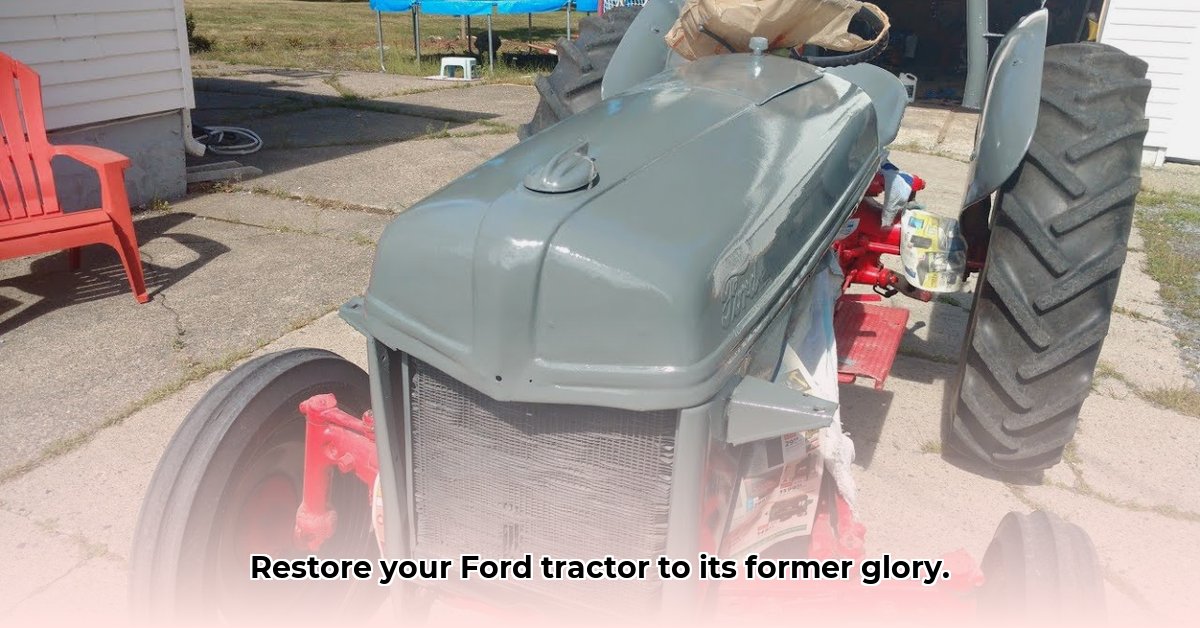
Revitalizing your classic Ford tractor? Achieving that perfect shade of gray can be a surprisingly complex undertaking. This comprehensive guide simplifies the process, from identifying the correct color for your specific model to navigating California's unique shipping regulations. We'll cover everything from sourcing the best paint to mastering painting techniques, ensuring a professional-looking finish—even if you're a beginner. For more detailed information on Ford tractor paint codes, check out this helpful resource: Ford Tractor Paint Codes.
Identifying Your Tractor's Unique Gray
The first step is pinpointing the precise shade of gray for your Ford tractor. This isn't always straightforward, as the color varied significantly depending on the year and model. Accurate identification is paramount for a successful restoration.
To aid your search, we've compiled a table of potential paint codes. Keep in mind, these are educated estimations. Visual comparison with known examples online, through owner's manuals, or via your local tractor club is essential for accurate identification. Pictures are invaluable!
| Ford Tractor Model & Year | Likely Paint Shade(s) | Important Considerations |
|---|---|---|
| 8N (1939-1952) | Multiple shades of gray; highly variable | Production year, even the production batch, significantly influenced the final color. Extensive visual references are crucial. |
| 600 Series (1952-1959) | Varies; check your owner's manual | Specific shades changed frequently during this era. |
| 9N/2N (1941-1946) | Highly variable | Numerous factors impacted paint consistency in the early years of production. |
Tracking Down the Perfect Paint: A Supply Hunt
Locating the perfect match can feel like a treasure hunt. Several suppliers offer paints claiming authenticity, with Tallmans (often formulated by Van Sickle) frequently cited. However, a 100% perfect OEM match is highly unlikely. Manage your expectations!
Here are your options:
- Spray Cans: Convenient for small touch-ups, but may lack the depth and evenness of larger formats.
- Quarts/Gallons: Best for larger projects, providing better color consistency and enabling multiple smooth coats.
- Enamel Paint: The preferred choice for a durable and authentic-looking finish.
Pros and Cons:
| Paint Type | Advantages | Disadvantages |
|---|---|---|
| Spray Cans | Easy, convenient for small jobs | Limited paint; may result in unevenness. |
| Quarts/Gallons | Better for large areas; superior evenness | Requires more equipment and experience for even application |
| Enamel | Durable, classic appearance, usually better finish | Requires more skill; longer drying times |
California Shipping Note: California's regulations may restrict certain paint shipments. Explore out-of-state suppliers or in-state vendors that comply with all regulations.
Prep Work: Laying the Foundation for a Stellar Finish
Proper surface preparation is critical. This non-glamorous step is the foundation of a successful restoration.
- Deep Cleaning: Remove all dirt, grease, rust, and old paint.
- Sanding: Smooth imperfections using progressively finer grits of sandpaper (e.g., start with 80-grit, progress to 220-grit for a smooth finish).
- Priming: Apply a high-quality automotive primer compatible with your chosen paint. This seals the metal, prevents rust, and ensures paint adhesion. Allow for complete drying.
Painting Time: Achieving a Smooth, Even Coat
Mastering painting techniques yields a professional-looking result.
- Thin Coats: Apply multiple thin coats instead of one thick coat to prevent runs and drips (a common mistake!).
- Consistent Application: Maintain a uniform distance from the surface, overlapping each stroke for even coverage. Experiment to find your optimal application technique for your chosen method.
- Drying Time: Allow adequate drying time between coats (check the manufacturer's instructions).
Finishing Details and Troubleshooting
Once the paint is completely dry, apply a clear coat for protection and enhanced shine.
Troubleshooting Common Issues:
- Runs and Drips: Caused by overly thick coats. Apply thinner coats and allow adequate drying time.
- Uneven Color: Ensure thorough mixing and even application.
- Surface Imperfections: Usually indicates inadequate sanding or surface preparation.
Key Takeaways: A Simplified Summary
- Finding the perfect Ford tractor gray requires careful identification of your tractor's model and year.
- Sourcing paint involves navigating various suppliers and considering shipping restrictions, especially for California residents.
- Meticulous surface preparation and proper painting techniques are paramount for a professional-looking result.